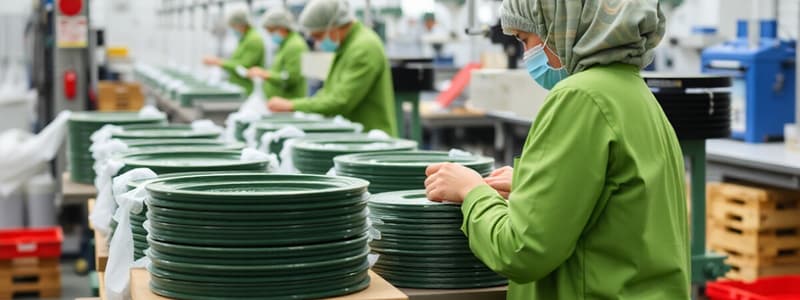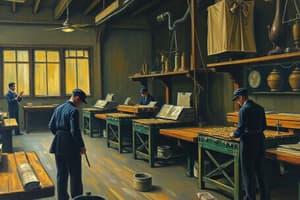Podcast
Questions and Answers
Which type of production is best known for its flexibility in meeting different customer specifications?
Which type of production is best known for its flexibility in meeting different customer specifications?
- Mass production
- Job production (correct)
- Flow production
- Batch production
What is a key advantage of job production regarding product uniqueness?
What is a key advantage of job production regarding product uniqueness?
- Lower production costs
- Custom-made products (correct)
- High production speed
- Standardized output
Which of the following is a main characteristic of workers in job production?
Which of the following is a main characteristic of workers in job production?
- Repetitive work on a production line.
- Involvement in completing the whole job. (correct)
- High specialization in a single task.
- Minimal skill requirements.
Why might job production be more expensive than other production methods?
Why might job production be more expensive than other production methods?
What is a primary advantage of batch production in terms of costs?
What is a primary advantage of batch production in terms of costs?
Which production method may lead to less interesting work for employees due to specialization?
Which production method may lead to less interesting work for employees due to specialization?
What is a major benefit of flow production related to output?
What is a major benefit of flow production related to output?
What is a potential issue with employee motivation in flow production?
What is a potential issue with employee motivation in flow production?
In flow production, what can be very expensive if production stops due to a breakdown?
In flow production, what can be very expensive if production stops due to a breakdown?
Which of the following describes a disadvantage of flow production?
Which of the following describes a disadvantage of flow production?
Flashcards
Job Production
Job Production
Craft workers produce unique items, often of high quality, leading to motivated workers and potentially higher prices for custom products.
Batch Production
Batch Production
Lower unit costs due to higher output and specialization; production is flexible, but planning can be complex, and small batches may increase costs.
Flow Production
Flow Production
Reduced unit costs, high-speed production, and flexible modern technology, but high set-up costs, low employee motivation, and potential for expensive delays.
Job production: Quality
Job production: Quality
Signup and view all the flashcards
Job production: Customization
Job production: Customization
Signup and view all the flashcards
Batch production: Cost
Batch production: Cost
Signup and view all the flashcards
Flow production: Speed and Flexibility
Flow production: Speed and Flexibility
Signup and view all the flashcards
Study Notes
- Different production types impact workers, production costs, output nature and quality, resource use, and the production environment.
- Each production method has its advantages and disadvantages.
Job Production
- Output quality is generally high due to skilled craft workers.
- Workers tend to be motivated by varied tasks and involvement in the entire job.
- Products can be custom-made, suiting customers who value uniqueness and are willing to pay more.
- Production can be slower with longer lead times compared to machine-based methods.
- It is often more expensive due to higher wages for skilled workers and the need for specialized tools.
Batch Production
- Unit costs are typically lower due to higher output, worker specialization, and machinery use.
- Production is flexible, accommodating orders with varying specifications.
- Planning and coordination can be challenging, especially when operations have unequal durations.
- Work may be less engaging for workers due to specialization.
- Small batches can lead to high unit costs.
- More capital can be tied up in work-in-progress.
Flow Production
- Flow production drastically reduces unit costs.
- Output is rapid, and production speed can be adjusted based on demand.
- Modern technology enables flexible production, allowing varied product specifications on the same line.
- Initial setup costs can be very high.
- Employee motivation may be low due to repetitive tasks.
- Products tend to be standardized.
- Production halts due to breakdowns can be costly for the business.
Studying That Suits You
Use AI to generate personalized quizzes and flashcards to suit your learning preferences.
Description
Job production uses skilled labor for custom, high-quality goods, but it's slower and pricier. Batch production lowers unit costs via specialization and machinery, offering flexibility but complex planning. Each method affects workers, costs, output, and resource use differently.





